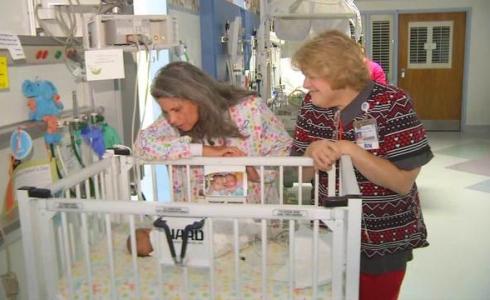What Types of Transplants are Performed at the University of Tennessee Medical Center?
The University of Tennessee Medical Center is a approved by Medicare to perform kidney, pancreas and combined kidney transplants. Our program offers potential kidney recipients both deceased and live donor transplants.
Is There an Age Limit?
There is no specific upper age limit for our program. Each patient is evaluated on a case-by-case basis, but must meet the center specific medical eligibility requirements.
Is There a Weight Restriction?
Each patient is evaluated on a case-by-case basis, but generally we require a body mass index (BMI) of 36 or less.
Do You Transplant Children?
Yes, our program performs kidney transplants for children. Children must be at least 16 years of age.
What Number am I on the List?
Your position on the wait list changes based on many factors according to the kidney allocation system through UNOS (United Network for Organ Sharing).These factors include your blood type, your time on the wait list and the characteristics of the donor. Given the current system, it is not possible to give you an actual number. The allocation system is currently under review by UNOS. There may be changes to the system in the next few years.
How Long Will I Wait?
The average waiting time varies according to different blood types and can range from six months to two years. Waiting time differs from transplant center to transplant center
Why is the Wait List Different at Other Centers?
Each center maintains its own wait list for their patients. Because not all patients are listed at the same center, the lists are always different.
Can I be Listed on More Than One Wait List?
Yes, if you choose. Being on more than one wait list can potentially decrease the time you are waiting for a transplant because you could now draw on a larger pool of deceased donors. However, many transplant programs share the same Organ Procurement Organization (OPO). Therefore, for multiple listing to be beneficial, it would be important to be listed in transplant programs that are located in different OPO donor service areas.
How Does the "On Hold" or "Inactive" Process Work?
There are times when your status might change from being “active” on the kidney waiting list to being “on hold” or “inactive”. During the time when you’re listed as on hold, you continue to accrue waiting time (seniority). However, you will not be available for a deceased-donor transplant. Your coordinator will let you know what is needed prior to reactivating you on the waiting list.
The reasons for being on hold vary, but might include health changes such as infection or hospitalizations. It may also include compliance issues or administrative issues such as your chart not being up-to-date. It may be a decision you make if you’re going on vacation, not emotionally or physically ready for transplant or if you’re waiting for a living donor.
What are the Types of Living Kidney Donors?
There are two types of living kidney donors, related and unrelated:
Living Related Donors are Healthy Blood Relatives of the Patient Requiring a Transplant. They can be:
- a sibling
- a parent
- a child over 18 years of age
- other blood relatives (half-sisters, half-brothers, nieces, nephews, aunts, uncles, cousins).
Living “unrelated” or “emotionally-related” donors are not blood relatives and usually do not share tissue similarities with the recipient. The donor can be:
- a spouse
- an in-law
- a close friend
- an adoptive parent
- an adopted child (over the age of 18)
- a significant other.
- Living “altruistic” donor is someone not blood related and does not have an emotional relationship with the transplant candidate. They simply want to help someone else.
What is Recovery Stage Like for a Donor?
The recovery period for living kidney donors depends on the type of donor nephrecotmy performed. All patients experience pain after any surgery and generally may need pain medicine for about a week. A follow-up visit with the patient’s surgeon is arranged for two weeks after the operation. Living donor should not drive or operate machinery until they are no longer taking pain medications.
Laparoscopic Donor Nephrectomy: One of the primary benefits of laparoscopic surgery is that it takes a shorter amount of time to recover from surgery. The recovery period for laparoscopic donor nephrectomy is about two weeks.
Only very vigorous physical activity such as weight lifting, other very heavy lifting or full contact sports need to be restricted for more than a week or two. Complications are unusual, but may occur as with any surgery. The surgeon will review potential complications with you in detail before the operation.
Open Donor Nephrectomy: The recovery period for an open donor nephrectomy is longer than when performed with a laparoscopic. The typical recovery period is four to six weeks. Donors should avoid heavy lifting, physical activity, and sports for at least 4 weeks.
Complications are unusual, but may occur as with any surgery. The surgeon will review potential complications with you in detail before the operation.
Who Pays for the Kidney Donor's Medical Evaluation, Surgery, and Follow-up Care?
Most costs for the living donor are covered by the recipient’s insurance coverage. However, this may vary with individual insurance payers. If you have questions about payment, please ask to speak to one of our financial counselors, and they will be happy to assist you.
What are the Benefits of Living Donation?
- Close to 95 percent success rate at one year after transplantation
- Living unrelated transplantation offers a significantly better success rate than a deceased kidney transplant
- Early kidney function
- Few rejections
- Fewer medications
- Avoidance of dialysis before transplantation in some patients
- Immunosuppression can be started prior to the transplant
- Long waiting periods that can occur with deceased donor transplants are eliminated
- Surgery can be scheduled when the recipient is in optimal medical condition
- Provides a significant psychological benefit to the donor.
What are the Benefits of Laproscopic Living Kidney Donation?
- Reduced length of hospital stay
- Earlier return to previous activity level
- Less discomfort following procedure
What Criteria Must a Living Donor Meet?
Potential donors must:
- Have compatible blood type with the recipient. If your blood is not compatible with the kidney transplant candidate, you may still be able to help the candidate transplanted by participating in a donor exchange.
- Have excellent medical health with perfect kidney function.
- Be willing to donate a kidney.
The evaluation of the living donor includes a medical history and physical exam, as well as tests for kidney function (blood and urine tests), liver function, cholesterol, hepatitis, HIV and other viral antibody tests.
Within a few months after the removal of one kidney, the remaining kidney enlarges and assumes approximately 90 percent of the function the kidneys had prior to donation. The life expectancy and general health of the living donor are not affected by the donation of one kidney. Therefore, life insurance premiums are not altered by kidney donation.
What are the Steps in the Living Donation Process?
Process: You have a genuine willingness to donate.
Follow-up: You may send an email to our Living Donor Coordinator (ADennis@utmck.edu) or call to speak with the live donor coordinator to let us know you are interested in donating a kidney to a loved one, friend or to anyone waiting on the list.
Process: We test your blood to determine if you are compatible.
Follow-up: Basic information about your health status will be requested at this time to determine if you are healthy enough to be tested as a donor. If this initial screening is passed successfully, plans will be made to test your blood.
Process: If you are willing to proceed, arrangements are made for blood testing.
Follow-up: Your transplant nurse or doctor will call you and discuss the results. It may take eight to 10 days to obtain the blood test results.
Process: If you are a suitable donor and if you are willing to proceed, arrangements are made for your medical evaluation.
Follow-up: The transplant office will arrange an appointment at the transplant clinic for your medical evaluation. If you live out of town, the transplant nurse will try to arrange workup at the nearest transplant center or your family doctor’s office.
Process: Your completed tests and reports are reviewed by the transplant physicians and nurses.
Follow-up: Any additional testing that is necessary will be arranged by the transplant nurse.
Process: If you are accepted as a living donor, final X-ray and compatibility testing is scheduled.
Follow-up: Your transplant nurse will schedule these tests. The final test is called a Computerized Tomography Angiography of your kidneys. It is a less invasive procedure done as an outpatient and you will not need to spend the day in the hospital for recovery. The findings will help the surgeons determine if the kidney can be removed by laparoscope.
Process: If your tests are satisfactory, the transplant is scheduled.
Follow-up: The transplant office will schedule a date with you and the transplant team.
If you would like to talk to someone who has been a living donor, the transplant nurse will be happy to provide you with the name of a contact person with whom you can discuss the donation process.
If you have any further questions or if you would like more information about any of the topics discussed here, please call our transplant office at the University of Tennessee Medical Center at 865-305-9236.
What is a Laparoscope and How is This Procedure Done?
A laparoscope is a long thin wand, generally about 18 inches long and ¼ inch in diameter. There is a microscopic lens at the end of the wand that projects images back to a camera.
The laparoscope is inserted into the donor’s abdomen using a tiny incision, and air is put in the abdomen in order to separate the patient’s organs, so the surgeons can see more easily. Then, two surgical instruments, each also about 18 inches long and less than a ¼ inch wide, are placed into the abdomen.
During the procedure, the donor is lying on his or her side, and the only other incision that is usually needed is a small horizontal incision, near the groin, for removing the kidney. This incision is generally about three inches long and is placed low in order to hide the scar and to use an area where muscle can be pushed aside without having to be cut.
In the “open” procedure, an incision that started at the patient’s navel and extended around to the back for about 8 inches was used. In both the laparoscopic technique and the old open technique, the left kidney is the preferred kidney for removal, because its vein is longer than the one on the right side. Still, at times, there may be medical reasons to remove the right kidney. With minor modifications, the laparoscopic technique can be used on the right side also.
How Long is the Laparoscopic Procedure?
The entire procedure takes about three and a half hours, which is very similar to the old method of operation. Because the intestines must be moved out of the way to remove the kidney, it can sometimes be two or three days before donors feel like eating again. However, the laparoscopic approach has resulted in shorter hospital stays and significantly less pain and discomfort for the donor and a quicker return to normal activity (usually within two to three weeks). Most living kidney donors will be eligible for the laparoscopic procedure.



